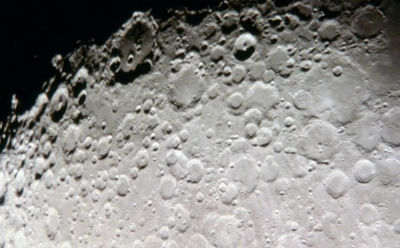Scanning the Heavens: Lessons from the Unfinished Cosmos
By Neil Earle
 NOVAS TOUCHING? There are wonders in the heavens far beyond what we can see in the night sky.
NOVAS TOUCHING? There are wonders in the heavens far beyond what we can see in the night sky.
The Great Eclipse of 2017 has come and gone. It is usually a healthy experience to get human beings to pay more attention to the heavens and less to the fractious illogical goings on with planet earth.
Yes, the cosmos. Fit meditation for any time any day.
It’s hard not to be impressed when we think about it. The dimensions of our cosmos in which we float as specks of dust (Sagan) don’t get any smaller. Years ago I taught audiences that there were about 100,000,000 stars in our galaxy and 100,000,000 galaxies, ever expanding.
Now we have to double these numbers and the update is no easier to grasp than the original.
Years ago I quoted physicist Paul Davies who said, “If physics is the product of design, the universe must have purpose, and the evidence of modern physics suggests strongly to me that that purpose includes us.” I expressed how Carl Sagan intoned beautifully that “the surface of the earth is the shore of the cosmic ocean…some part of us knows this is where we came from…we long to return.”
“Discoverer” of the Black Hole concept, Dr. John Wheeler once said: “There must be at the bottom of it all a very simple idea.”
Sagan, that relentless setter forth of astronomy as a wonder and enchantment, may fit what people said about Einstein, “a non-believing believer.” He sounded positively religious when he hymned the praises of a universe possible containing 10,000,000,000,000,000,000,000 stars (by conservative reckoning).
 Carl Sagan challenged Christians and non-Christians alike with his groundbreaking "Cosmos" series in the 1980s.
Carl Sagan challenged Christians and non-Christians alike with his groundbreaking "Cosmos" series in the 1980s.
Staggering Realities
We earth-dwellers are 4.6 light years from the nearest star other than our own sun. Some have concluded over the years that these vast numbers and distances make what we are doing on earth almost totally irrelevant. Nihilism and spiritual paralysis can result. C.S. Lewis the Christian advocate, argued against that point, saying instead that he might feel claustrophobic in a universe that had limits and God’s glory could be diminished. A number of Old Testament texts declare how God “stretched out the heavens” matching what we know about that cosmic reality today – a boundless but expanding and ultimately finite universe. The assumption of the continually expanding universe has generated acceptance for the Big Bang theory among most physicists.
Bottom line? The size and the scope of the universe are staggering. As is its grandeur and ability to generate awe from believers and non-believers alike. We are almost overwhelmed at the brilliant colorful displays in the heavens – its rational order along with its unpredictable aspects.
Adopted by the Creator/Son-Ship with God
The process of becoming God’s sons is spelled out across the Bible. It begins with God’s calling us to want to change from what we are – accepting his gift of repentance. This prepares us for receiving the vivifying gift of the Holy Spirit which begins to transform us from the inside. We begin to “participate in the divine nature” (2 Peter 1:4). This makes us more God-like over a period of time and testing. Then, while already newborn sons of God adopted into the God family our transformed state is conferred at the resurrection of the just at Christ’s return.When Jesus returns we shall be like him (Philippians 3:21; 1 John 3:2). And then things really start to happen.
Orderly…yet Unpredictable
Unpredictable? Yes. Meteors and cratered, battered astral surfaces such as the moon’s show that there is much more disorder occurring out yonder than we usually chose to think about. The spectacular colored novas and wispy tendrils of gas clouds spanning the heavenly backdrop that our telescopes are sending back to earth are reporting either remains of exploded galaxies that “didn’t make it” or new entities coming into being across the stellar distances. The whole thing is so vast and beyond us that it makes, said Albert Einstein, our thinking and reasoning “an utterly insignificant reflection.”
Scientific theologian Jeffrey Sobosan writes of this in Romancing the Universe mentioning how “explosions and collisions (seem) the order of the day.” He is intrigued by the sobering proposition that the whole thing is held together by “little more than nuclear bonding forces, with electromagnetism and gravity.” This, says Sobosan, underscores unpredictability but it is an unpredictability which opens the door for novelty and newness to thrive, as we shall see.
Biblical Stargazers
For centuries Christians and other s have been inspired by the words of King David in the Bible: “When I consider your heavens, the work of your fingers, the moon and the stars, which you have set in place, what is man that you are mindful of him, the son of man that you care for him (Psalm 8:1-3)?”
The Hebrew prophet Isaiah took it a step further: “Lift your eyes and look to the heavens: Who created all these? He who brings out the starry host one by one, and calls them each by name. Because of his great power and mighty strength, not one of them is missing.”
These are startling reflections for hundreds of years before Christ. Somehow ancient Hebrews knew that Yahweh their God, being Creator, had the universe exist at his discretion. That meant there had to be a purpose and it was left to Bible writers to scope out the broad outlines of this purpose. “For thus says the Lord, who created the heavens (he is God) who formed the earth and made it…he did not create it empty, h formed it to be inhabited” (Isaiah 45:18).
The context seems to be referring back to humanity overspreading the earth after Genesis 1, the original creation of humankind, but could it mean more?
 Atheist Fred Hoyle, inventor of the term "Big Bang," speculated that "a superintellect has monkeyed with physics" to prevent the Big Bang from dissipating itself soon after the everywhere explosion.
Atheist Fred Hoyle, inventor of the term "Big Bang," speculated that "a superintellect has monkeyed with physics" to prevent the Big Bang from dissipating itself soon after the everywhere explosion.The Other Side
The universe is truly resplendent and following the laws seemingly set out for it but… as one Christian thinker phrased it, it seems to be waiting for something. Our unfinished cosmos seems to be somehow incomplete and that is what Bible writer St. Paul addressed in Romans 8. A biblical teacher in our day has phrased it as a creation waiting for “a beautifying finish to be applied,’ like well-constructed but unfinished furniture. St. Paul, when considering the cosmos with God in the picture, used the analogy of a birth waiting to happen, a new experience that will radically involve all those planets and stars away out there.
“We know that the whole creation has been groaning as in the pains of childbirth right up to the present time” (Romans 8:22). That seems like a fair deduction. There is the beauty of Andromeda and yet the brutal chaos inside black holes. We have the amazing symmetry of the planets and yet the battered surface of Mercury which looks, said one astronomer that it has had a bad night out.
The Universe: Waiting for…What?
These realities underscore Paul’s previous statements about the cosmos: “For the creation was subjected to frustration, not by its own choice, but by the will of the one who subjected it, in hope that the creation itself will be liberated from its bondage to decay and brought into the glorious freedom of the children of God.”
“The glorious freedom of the children of God.” Paul talks here about the physical realm escaping the limits that have been imposed on it. In his writings he writes much of us individual Christians escaping bondage to the downward pulls of the flesh, debilitating encounters that drag us down like gravity. We ourselves, he says to his fellow believers, “groan inwardly as we wait eagerly for our adoption as sons, the redemption of our bodies.”
So…as goes the struggling sinner so goes the cosmos, Paul says. Then comes his payoff verse in Romans 8:19, “the creation waits in eager expectation for the sons of God to be revealed.”
Just what is Paul saying here?
 Pockmarked lunar surface: What Buzz Aldrin called 'magnificent desolation' shows the cosmos may need some renovation in the future.
Pockmarked lunar surface: What Buzz Aldrin called 'magnificent desolation' shows the cosmos may need some renovation in the future.A Glorious Destiny
He is using the fact of our wondrous and bewildering cosmos to show that things are not all finished yet. In the plan of salvation individual Christians must wait for Jesus Christ to return for this renovation to begin. Revelation 22 shows God the Father descending to this planet in a new city that will be the center of the new order.
Hmmm. We hear little about this today bombarded with our daily morass of bad news.
Yet this was part of the first century gospel of the Kingdom of God, an implication arising from Jesus’ ascension to the Father to receive full control over the entire universe and foretold in the First Century church’s favorite text – Psalm 110. But it’s there in the New Testament writings. Hebrews 2:8 shows God’s purpose to bring “many sons to glory.” (see Box) The book of Revelation’s promises to the seven beleaguered churches includes sitting with Jesus and the Father in the throne of the universe (Revelation 2:27). St. Paul exhorts the Corinthians that they will judge the world, they will judge angels.
Can we believe that this is what the creation waits for? Years ago I wrote about Project Universe, speculating that the children of God would be enlisted in the final beautification and reordering of the universe. It still seems somewhat radical to write that even now. Yet Christians know that God’s kingdom has no end. The phrase “forever and ever” means something in this context. An expanding universe fits in well with an endless kingdom. The implications of all this are striking and lend force and gusto to the Kingdom message Christians are asked to advance.
The 1700s theologian Jonathan Edwards expressed it this way: “There are many reasons to think that God intends an increasing communication of himself through all eternity…For the whole universe is put into subjection to Jesus Christ that all things may be ordered by him, in subservience to the great design of redemption.” Such seems to be the implications of such texts as Ephesians 1:9-10 and Jesus’ repeated statements that his disciples would sit with him in his throne (Matthew 19:28). God has his eyes on all believers and he also has his eyes on the multitudinous stars which adorn the nightly theatre in the heavens. Could it be that the God who “stretched out the heavens” (Isaiah 42:5, 44:24; 45:12, 51:13; Jeremiah 10:12) sees a link between God’s work of salvation and the cosmos?
The Biblical evidence seems to answer in the affirmative. Right from the beginning humankind was given dominion over the things of the earth, as both Genesis 1 and Psalm 8 show. The New Testament follows this with news of our adoption into God’s family through a spiritual rebirth (Romans 8:3). Hard to believe but we sinning failing mortals have a claim – through adoption – to the whole universe. Being God’s children means something, something very big indeed.
Is this God’s plan for us? The apostle Paul told the Corinthian Christians it was their destiny to judge the world, and then to judge angels! Some feel we are to join the Father and the Son in a mind-expanding mission to halt the process of decline and decay in the universe and turn it into a “finished symphony” of a more glorious New Heavens and New Earth. Can this be true? Will we help in the rescue and redemption of physical nature from the very laws that brought it into being and that also seems to grind it down at the same time?
Are we meant to carry out a beautifying finish on the entire cosmos? Is this the simple idea John Wheeler had in mind?
The implications seem to be there all across Scripture. What do you think?